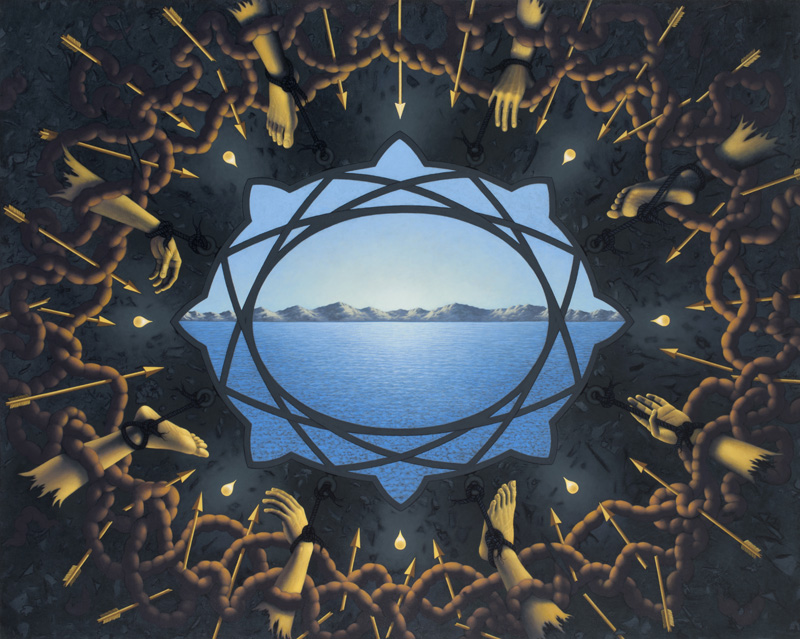
 |
| Window of Seven Tears 2004, acrylic on canvas 48 x 60 in. |
Window of Seven Tears |
Like all my work the Window of Seven Tears focuses on the ideas of change, transformation, and transcendence, specifically as they relate to the human condition. To me these ideas represent the core of a philosophically meaningful perspective of life; that everything is trapped in time, constantly changing and transforming, and the thought of such a condition is so unsettling that we seek transcendence from that dilemma. In the Window of Seven Tears these ideas take shape through the overall composition in union with the individual forms and their interrelationships. The composition consists of three distinct parts - the foreground, the window, and the transcendent space beyond. The foreground represents earthly existence and is depicted as a dynamic and darkly foreboding space with piercing arrows and bound severed limbs entangled by a winding chain of intestines. Gold teardrops illuminate small portions of the dark space and symbolically reference the pain, suffering, grief, anguish, and joy we feel during our existence. The window represents the opening or view we have to a more hopeful existence. It is a geometric stylized-eye with tear-ducts from which the tears flow. Gazing through the window we see an idealized landscape beyond. It represents the potential for hope. It is a blue light-filled transcendent space containing a glitteringly serene sea and an alluringly tranquil mountain formation rising on the distant horizon. The Window of Seven Tears is particularly replete with individual forms. Some, like the arrows, the window, and the tears were new to my work while others, like the intestines, the severed limbs, and the landscape had been previously explored. Each form possesses a symbolic meaning within the context of the piece. For example, the intestines reference entanglement, or the idea that everything is inextricably bound to nature. In that regard the intestines entangle the severed limbs, which represent the dissolution and horrors of life, and the arrows, which represent chance and the world by forming the 8 primary hexagrams of the I Ching. Music is also explored in the piece. The spacing and placement of the limbs and arrows along with the entanglement of the intestines suggest a musical rhythm. The title of the painting itself is based on the Renaissance composer, John Dowland's masterwork, Lachrimae, or Seaven Teares, 1604. His is a melancholy piece, which has been described as being created by a "… terrestrial creature yearning for Eternity…" I have attempted to capture that same sense of melancholy and yearning in the Window of Seven Tears. However interesting my intentions for the piece may be, or how enriching the individual forms and their symbolic meanings are, they are ultimately secondary to the work's overall focus and subordinate to the pure experience of the work. - Brian Mains, December 2018 |